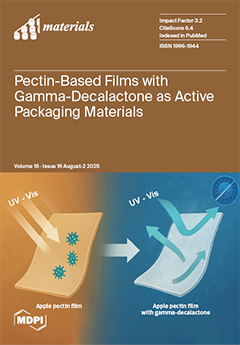The present study aims to investigate the orientation-dependent mechanical behaviors of ZnO single crystals under nanoindentation by molecular dynamics simulation. The load–indentation depth curves, atomic displacement, shear strain and dislocations for the c-plane, m-plane and a-plane ZnO single crystals were analyzed in detail.
[...] Read more.
The present study aims to investigate the orientation-dependent mechanical behaviors of ZnO single crystals under nanoindentation by molecular dynamics simulation. The load–indentation depth curves, atomic displacement, shear strain and dislocations for the c-plane, m-plane and a-plane ZnO single crystals were analyzed in detail. The simulation results showed that the elastic deformation stage of the loading curves for the three oriented ZnO single crystals can be described well by the Herz elastic contact model. The Young modulus values for the c-plane, m-plane and a-plane ZnO were calculated to be 122.5 GPa, 158.3 GPa and 170.5 GPa, respectively. The onset of plastic deformation occurred first in a-plane ZnO, then in m-plane ZnO, and lastly in c-planeZnO. The atomic displacement vectors in the three oriented ZnO single crystals were in good agreement with the primary activated slip systems predicted by the maximum Schmid factor. For the c-plane ZnO, the activated pyramidal {
}<
> slip system led to a complex dislocation pattern surrounding the indenter. A U-shaped prismatic half-loop was formed in the [
] direction, confirming the activation of the prismatic {
}<
> slip system. For the m-plane ZnO, the activated prismatic {
}<
> slip system led to the preferential nucleation of dislocations along the
and [
] directions. A prismatic loop was formed and emitted along the [
] direction, governed by a confined glide on {
} planes. For the a-plane ZnO, the activated prismatic {
}<
> slip system led to dislocations concentrated in the [
] direction beneath the indentation pit, emitting a prismatic loop along this direction. Perfect dislocation (with a Burgers vector of 1/3 <
>) is the dominant dislocation in the three oriented ZnO single crystals. The findings are expected to deepen insights into the anisotropic mechanical properties of ZnO single crystals, offering guidance for the development and applications of ZnO-based devices.
Full article






